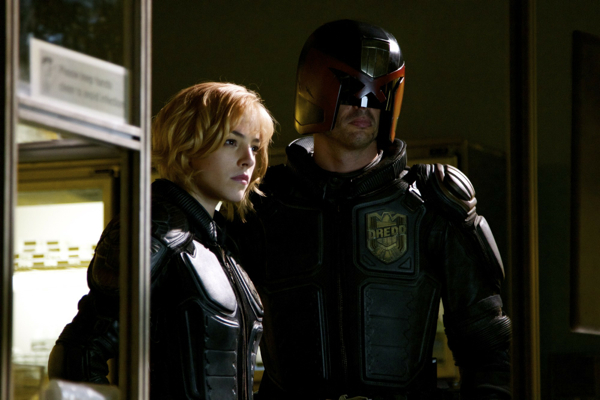Movie review by Greg Carlson
A vast improvement over the weak 1995 adaptation by Danny Cannon, “Dredd” better understands the pulp sensibilities of the dystopian nightmare patrolled by Mega-City One Justice Department employee Joseph Dredd (Karl Urban), the grim, perpetually helmeted law officer whose authority as a judge fuels the fanboy power dream of immediate arrest, sentencing, and execution (when necessary, which is to say, very often). The suggestion that elevated future crime rates – the first Dredd story was set in 2099 – have necessitated a radical overhaul to the entire judicial system certainly won’t comfort those who identify as anti-authoritarian, but the comic book’s police state resides comfortably in a fantasy realm where the law represents a sane refuge from the hellish threat of drooling thugs.
Lame explanatory voiceover notwithstanding, director Pete Travis dispenses with most of the leaden exposition that weighs down so many movies aiming to please existing fan constituencies while simultaneously grubbing for new ticket buyers. Wisely, the audience is invited to identify with rookie Cassandra Anderson (Olivia Thirlby), a mutant who can read the thoughts of others. Assigned to Dredd for a probationary evaluation, Anderson’s unique psychic abilities allow her to recognize nuance and complexity that contrasts sharply with Dredd’s rigid application of the rulebook. Cult screenwriter Alex Garland’s snapshot “day in the life” approach limits the principal conflict to one primary location, a concrete jungle housing project where Madeline “Ma-Ma” Madrigal (Lena Headey) conspires to consolidate the megalopolis’ trafficking of Slo-Mo, a crystal meth-like synthetic.
Action movie aficionados will no doubt recognize similarities between “Dredd” and “The Raid: Redemption,” the Indonesian martial arts thriller directed with panache by native Welshman Gareth Evans. Both movies revolve around the infiltration of high-rise slum blocks controlled by drug-dealing crime lords. Both movies feature showdowns in narcotics laboratories. Both movies include trapped law enforcement officers threatened by scores of bloodthirsty residents. Each movie treats violence with an obsessive degree of aesthetic care and concern.
Many of the film’s most unexpected surprises come courtesy of the impressive talent pool aiding Travis behind the camera. Frequent Lars von Trier and Danny Boyle collaborator Anthony Dod Mantle photographs the interiors of the Peach Trees block with a strong affinity for classic noir, and his collaboration with visual effects supervisor Jon Thum on a series of slow motion explorations of stomach-churning violence invests the visuals with a repulsive beauty. Grisly shots of bullets tearing through flesh and bone compete with low-angle, through-the-floor views of bodies plummeting to the pavement.
There is just enough gallows humor to keep “Dredd” from becoming overwhelmingly morose, and Garland thankfully holds the number of puns and one-liners to a minimum. The story’s chief deficiency is the handling of Ma-Ma. Headey is a wonderful actor, and Ma-Ma is presented as a shrewd opponent, but the best villains contain some element of humanity and Ma-Ma never lets down her guard as a ruthless tyrant. Wood Harris, as a gang lieutenant in the custody of Dredd and Anderson, has a better opportunity to develop a rounded character. A truly worthy Judge Dredd movie might explore the idea that the title character’s tendency to dispense blistering beatdowns is every bit as sadistic as the criminal behavior of the villains.
